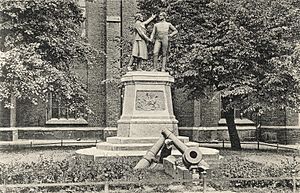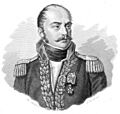Siege of Kolberg (1807) facts for kids
Quick facts for kids Battle of Kolberg (1807) |
|||||||
|---|---|---|---|---|---|---|---|
| Part of the War of the Fourth Coalition | |||||||
 Former battle memorial with statues of Nettelbeck and Gneisenau in Kolberg |
|||||||
|
|||||||
| Belligerents | |||||||
|
|
||||||
| Commanders and leaders | |||||||
| Strength | |||||||
| 14,000 41 guns |
6,000 230 guns 46 guns on Swedish frigate |
||||||
| Casualties and losses | |||||||
| 5,000 killed, wounded or captured | 3,000 killed, wounded or captured | ||||||
The Siege of Kolberg was an important event during the Napoleonic Wars. It happened from March to July 1807. During this time, the French army, led by Napoleon Bonaparte, tried to capture the fortified town of Kolberg (now Kołobrzeg) in Prussia. Kolberg was the last Prussian stronghold in the region of Pomerania that the French had not taken.
The French army had many allies, including soldiers from Italy, Holland, and various German states. Polish soldiers also joined the French side. Despite being surrounded and attacked for months, the people defending Kolberg did not give up. They were helped by a brave Prussian officer named Ferdinand von Schill and a local leader named Joachim Nettelbeck. The siege ended when a peace treaty was signed, meaning Kolberg remained in Prussian hands. This was a big deal because most other Prussian fortresses had fallen to Napoleon.
Contents
Preparing for the Siege of Kolberg
After Prussia lost a major battle in October 1806, French troops moved into Prussian lands. Many Prussian cities and fortresses surrendered quickly. However, Kolberg decided to fight back. This surprised the French and even some Prussian officials.
Building Defenses and Gathering Troops
The commander of Kolberg, Lucadou, refused to surrender the town. He ordered the area around the fortress to be flooded to make it harder for the French to attack. They also built new defenses, like a strong point called Wolfsberg sconce. Many Prussian soldiers who had been defeated in earlier battles found safety in Kolberg, helping to increase its defenders.
Schill's Brave Actions
A young Prussian officer, Ferdinand von Schill, became a hero during this time. He led a small group of cavalry (horse soldiers) and attacked French units outside Kolberg. He gathered supplies and recruited new volunteers. Schill's small victories, though not huge, were the first Prussian successes against the French. This made him famous, and the Prussian king ordered him to form a special volunteer unit called a freikorps. Schill's actions helped delay the French attack on Kolberg, giving the defenders more time to prepare.
Getting Ready for Battle
Kolberg needed more defenses, soldiers, and weapons. The town's old defenses were not in good shape. Over time, more soldiers joined the garrison, growing to about 6,000 men. They also received some help from Sweden and Britain, who sent weapons and supplies by sea. Local workers even made new rifles and fixed old cannons to prepare for the fight.
French Commanders and Their Delays
Napoleon Bonaparte first put Claude Victor-Perrin in charge of taking Kolberg. But Schill's forces captured Victor-Perrin, which delayed the French attack. An Italian division, led by Pietro Teulié, then began marching towards Kolberg. Schill's freikorps continued to slow them down with small battles. By mid-March, the French forces finally surrounded Kolberg.
The Siege Begins
Once Kolberg was surrounded, Schill's cavalry left to help other Prussian and Swedish forces. The defenders burned down buildings outside the fortress to prevent the French from using them for cover.
Changes in Command
Because of the delays, Napoleon replaced Teulié with General Louis Henri Loison to lead the French siege. The Prussian king also made a change, replacing Lucadou with Major August Neidhardt von Gneisenau to command Kolberg's defense. This was partly because the British were expected to help, and Gneisenau had experience with them.
Reinforcements Arrive
The French army received more troops from various German states that were allied with France. A Polish regiment of 1,200 soldiers also joined the French side. These Polish soldiers were very eager to capture Kolberg, as it had historical ties to Poland.
Fighting During the Siege
Much of the fighting focused on the Wolfsberg sconce, a key defensive position east of Kolberg.
Siege Forces and Their Plan
By early May, the French siege army had about 8,000 soldiers. They divided their forces into four brigades, each with different units, including Polish, Italian, and German soldiers. The main French headquarters was in Tramm, and their artillery was set up near Zernin.
Kolberg's Defenders
Schill returned to Kolberg for a short time but left again with most of his cavalry. The defenders inside Kolberg numbered about 6,000 men. They were made up of various battalions and companies, including some of Schill's infantry and cavalry.
Battles at Wolfsberg Sconce
On May 7, French and allied troops attacked Wolfsberg sconce. Polish soldiers bravely fought off a Prussian cavalry charge. Later, on May 17, the French managed to take part of the sconce but had to retreat due to confusion and friendly fire between their own units. The Prussians then took it back.
Supplies and Reinforcements
On May 20, Britain sent more weapons and ammunition to Kolberg by sea. These supplies helped the defenders. On June 11, after heavy fighting, Wolfsberg sconce finally fell to the French. General Teulié was badly wounded during this time.
The defenders also received help from the sea. A British ship and a Swedish frigate (a type of warship) fired their cannons at the French positions. Local citizens, led by Nettelbeck, even armed fishing boats with small cannons to help defend the town from the water.
The Final Days of the Siege
In mid-June, the French forces grew even larger, with new troops from Nassau and Holland. Napoleon sent more experienced French regiments and heavy cannons to finish the siege. The French army grew to about 14,000 men.
Heavy Bombardment
The French launched a massive attack on July 1, taking the Maikuhle forest from Schill's remaining soldiers. Kolberg was heavily bombarded with cannonballs. Thousands of cannonballs hit the town in the last two days of the siege.
Peace Treaty and Outcome
On July 2, the fighting stopped. A peace treaty, called the Peace of Tilsit, had been agreed upon. This meant the siege was lifted, and Kolberg was not occupied by the French army. Kolberg was one of the few Prussian fortresses that successfully resisted Napoleon's forces until the war ended.
After the Siege
After the peace treaty, the French army left Kolberg. The commanders who defended Kolberg, Ferdinand von Schill and August Neidhardt von Gneisenau, received high military honors for their bravery.
Damage and Rebuilding
The siege caused a lot of damage to Kolberg. The areas outside the town were destroyed, and more than half of the old town was damaged by artillery fire. The town's economy suffered greatly. It took many years for Kolberg to rebuild and recover. The old town hall, which was destroyed, was replaced by a new building designed by a famous architect, Karl Friedrich Schinkel. Kolberg stopped being a fortress in 1872, and its defenses were removed.
Kolberg in Memory
The successful defense of Kolberg became a famous story in Prussian history. A writer named Paul Heyse even wrote a play about it. Before World War II, there was a monument in Kolberg dedicated to Gneisenau, Nettelbeck, and Schill. July 2, the day the siege ended, was celebrated as a local holiday. After World War II, when Kolberg became part of Poland, a street was named after Antoni Paweł Sułkowski, the commander of the Polish troops who fought in the siege.
The Kolberg Movie
During World War II, the Nazi government made a very expensive propaganda movie called Kolberg. It was based on Paul Heyse's play. The movie changed some historical facts; for example, in the film, the French gave up because they couldn't take the city, but in real life, the siege ended because Prussia signed a peace treaty. Thousands of soldiers and sailors were taken from the war front to act in the movie.
Images for kids
-
Kingdom of Prussia, 1806
-
Schinkel's town hall



















